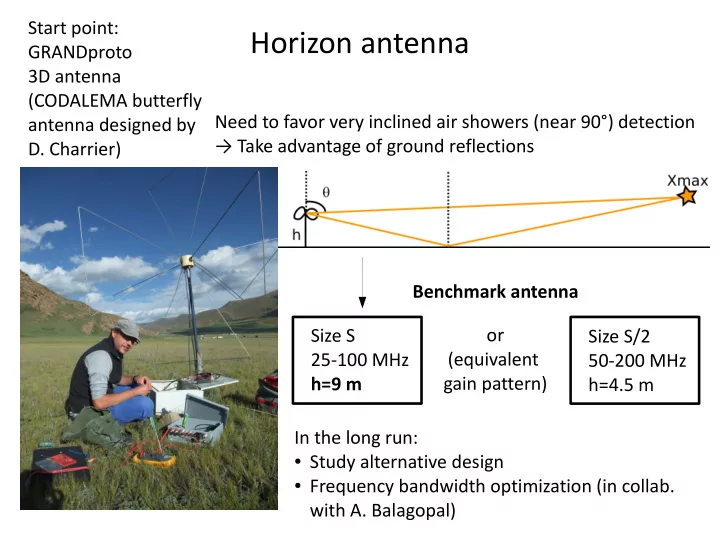

Start point: Horizon antenna GRANDproto 3D antenna (CODALEMA butterfly Need to favor very inclined air showers (near 90°) detection antenna designed by → Take advantage of ground reflections D. Charrier) Benchmark antenna or Size S Size S/2 (equivalent 25-100 MHz 50-200 MHz h=9 m gain pattern) h=4.5 m In the long run: ● Study alternative design ● Frequency bandwidth optimization (in collab. with A. Balagopal)
Antenna gain pattern Symmetrical pattern for j > 90° G( q,j ): unloaded butterfly antenna X-arm response to q,j wave @ 50 MHz NEC4 simulation wih infinite ground (“sandy dry”) hypothesis → G = 0 @ q >= 90°, huge gradiant (<-18dB between 80 & 90°), effect of infinite ground simulation
Antenna gain pattern Effect of a realistic ground (simulation) G > 0 @ q >= 90° q SKALA antenna, H plane, 150 MHz (from SKA paper) Infinite ground Soil Mesh over soil https://arxiv.org/ftp/arxiv/papers/1512/1512.01453.pdf
Antenna orientation Y-arm X-arm a,b, angles of ground normal vector (=antenna pole) in GRAND frame computed from topography with 30 m step data ● Antenna X-arm and Y-arm // to ground ● Projection of X-arm and Y-arm on XY plane along NS & EW
Antenna orientation ^ to ground 18° tilt If antenna pole is not put ^ to ground → arms are not // to ground 75 MHz 125 MHz 175 MHz → antenna response does not differ much for q in 80-90°
GRAND frame to antenna frame Hyp. : all radio emission comes from X max position → calculation of X max direction in antenna frame ( q ant ,j ant ) to apply antenna response
Antenna voltage response V= L eq ( n,q,j ). E L eq : equivalent length of antenna connected to a circuit RLC (300 W, 6.5e-12 F, 1e-6 H ) V pp V pp V pp NS~0 UP EW
Events selection Stationnary noise @ 50-200 MHz ● Ground: T ~ 290 K black body ● Sky: LFmap (galaxy..) T(direction, LST) Atmosphere T ~ 0 K ● Tot: V rms ~ 15µV → Selected air shower event if Add noise + Pessimistic (conservative) hyp. digitization of V 8+ antennas with V pp > 10 V rms (noise) Optimistic (agressive) hyp. 5+ antennas with V pp > 3 V rms (noise) & antennas are selected if not isolated: V pp > 10 V rms distance to 1+ other selected antenna(s) < 2 antenna array step
t events simulation 20 000 (detectable) t events are simulated, between 10 17 to 10 21 eV Decay positions of t (weighted by Waxman-Bahcall 1/3 n t flux) Hotspot 500 m step antenna array ~ 10 000 km²
antenna array t event example ~ 10 000 km² -25 m EW -75 m antennas in the 3° light cone array step = 500m holes ↔ mountain shadowing antennas with a computed voltage additional holes ↔ q ant (X max ) > 89.5°
Ground slope affects voltage a = zenithal angle (deg) of ground normal vector V pp (µV) q ant = Xmax zenithal angle in antenna frame Big differences of a for nearby V pp = f( q ant ) & q ant = f( a) antennas: calculation of a from 30m step topography not accurate → Limitation for V pp computation accuracy
t events simulation Optimistic hyp. 1000 m step array Number of antennas per shower Not in moutain shadow With a computed voltage Which triggers on V pp condition
Agressive = Optimistic hyp. Exposure Conservative = Pessimistic hyp. Preliminary study and new As expected, conservative hyp. (8+ antennas with study compatible V pp > 10 V rms (noise) ) cuts a lot of low energy events, but keeps half of high energy events
Agressive = Optimistic hyp. Exposure Conservative = Pessimistic hyp. 100m step array: density = 1 ant / km² 500 m step array: density = 4 ant / km² Density *4 Exposure ~*2 1500 m step array density = 0.44 ant / km² Density /2.3 Exposure ~/2
t detection rate t detection rate (yr -1 ) = exposure (1 yr) * flux * dE flux = Waxman-Bahcall, 1/3 n t = 2e-4 /3 * E-2 GeV -1 .m -2 .sr -1 .s -1 Prelim. study optimistic: 2.8 yr -1 500 m light cone: 7.568 +-0.097 yr -1 500 m optimistic: 2.975 +-0.032 yr -1 500 m pessimistic: 0.807 +-0.008 yr -1 1000 m optimistic: 1.490 +-0.021 yr -1 1000 m pessimistic: 0.299 +-0.004 yr -1 1500 m optimistic: 0.720 +-0.009 yr -1 1500 m pessimistic: 0.118 +-0.001 yr -1
Optimistic hyp. t detection rate (decay positions) 1000 m step array antenna array ~ 10 000 km²
t detection rate (directions) Optimistic hyp. 1000 m step array To South upgoing downgoing To South To North ● We might get more upgoing events with a proper ground in the simulation of antenna response ● t events mainly come from North (they travel towards South) because Southern ridge of Tianshan mountains act as target for neutrino decays
Conclusion & to do Conclusion ● Results of new simulation compatible with preliminary simulation ● Improvements on exposure depend on antenna design and its fair simulation To do ● Comparison with a flat array to quantify topography effects ● Comparison with a real topography array but with vertical antennas to quantify the effect of the antenna response ● Simulation for arrays in the whole Western China (to be done for March 2018) ● Find a way to simulate antenna response with a realistic ground (HFSS?)
Recommend
More recommend